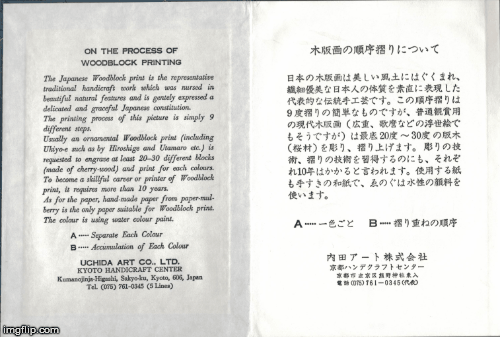An Introduction to Japanese Woodblock Printing
Japanese woodblock printing originated in ancient China and was brought to Japan after the unification of the country and Shogunat rule was established. Japanese woodblock prints, also called ukiyo-e (which means image of the floating world), are a traditional art form, which started to become very popular in the newly created capital Edo (now Tokyo) from around 1600 and are now highly sought after by art enthusiasts all over the world.
Buddhist origin
Woodblock printmaking came to Japan from China, probably around the 8th century. At that time, the two countries were connected by an intensive cultural exchange. In the year 770, Empress Shotoku, under consultation with China, commissioned some of the first known text prints: the Dharani (Buddhist verses), each stored in a small wooden pagoda. However, it has not been established from which material these plates were made.
To begin with, woodblock printmaking was only conducted in Buddhist monasteries, in order to reproduce Buddhist texts and images, also later for books. At the start of the 17th century, private printmaking studios began to open. These early prints were presented in black and white.
Colored woodblock prints
In the middle of the 17th century, the artist Moronobu was one of the first to create a single sheet woodblock print. These new and affordable prints became very popular within Japanese society. The early black and white prints (sumizuri-e) were soon updated and coloured by hand (sumizuri-hissai). The available color palette quickly expanded with the introduction of new materials, such as metal dust.
In the first half of the 18th century, printers began to print from two or three plates, which provided the opportunity to print in two or three colors. Soon, the invention of the pass mark, the kentō, made these multicolor prints more precise. This technique made it possible to print from multiple plates whilst maintaining high accuracy. The artist Harunobu was one of the first to extend and refine this technique by designing prints using more than 20 plates. These magnificent new prints were called brocade images (nishiki-e).
Ukiyo-e in the Edo Period
Japanese woodblock printmaking had its heyday during the Edo period (1603-1868). After centuries of civil war, this was a time of inner peace. In 1603, the sovereign, Tokugawa Ieyasu, had won an important battle and became the new shogun. This position was held by his descendants until 1868. Ieyasu chose the fishing village of Edo (now Tokyo), where he had already established his headquarters, as the new capital. Far from the Emperor's court at Kyoto. The new capital grew very quickly, attracting craftsmen and salesmen. A wealthy and prosperous middle class also developed, who enjoyed an intense cultural and social life. This was partly due to the restrictive regime, who refused its citizens any access to political power. Theatre, sumo and brothels all became very popular during this period.
The artists expressed the spirit of this new era in their imagery: the “image of the floating world”, or ukiyo-e.
How a woodblock print is created
The process of making a Japanese woodblock print is generally divided into three main steps:
- The artist draws the design on thin paper. The artist then leaves their designs in a workshop with
- a woodcarver. The woodcarver places the paper on wooden blocks, usually made from cherry wood, and engraves the blocks using the appropriate chisels and gouges. Blocks are carved one by one, each colour a new woodblock. The blocks are then taken to the printer, who arranges the blocks in sequential order and prints them on Japanese rice paper (which is made from mulberry bark) using water colours.
- The final step is to sell the woodblock prints. This is when a publisher takes over, taking responsibility for all further decisions. During the Edo period (1603 – 1868) there were more than 2.000 active publishers. Additional craftsmen were also involved in the process, such as papermakers.
Topics of ukiyo-e
There were a wide variety of themes. To begin with, legends were the most popular, along with images of the kabuki theatre. The artist Harunobu designed prints depicting scenes of everyday life. Utamaro was famous for his fine portraits of beautiful women. At the end of the 18th century, landscapes and animals also became popular with artists, including the masters Hokusai and Hiroshige.
Japonism
In 1853, American ships forced Japan to open her ports. This resulted in dramatic social change. The shogun had to step down and a Meiji Emperor (1868-1912) was crowned. Japan soon began to embrace Western culture, in stark contrast to the time before, when contact with Westerners was strictly forbidden. Western printmaking techniques were introduced to Japan, leading to the traditional woodblock print quickly losing its appeal. This was also partly due to the fact that woodblock printing wasn't considered to be high quality fine art within Japanese society.
Woodblock prints were exported to Europe and caused a great sensation, strongly influencing art movements such as the Jugendstil and the new poster movement. Many Impressionists, such as van Gogh, Gauguin, Monet and many others, not only started to collect Japanese woodblock prints, but were clearly influenced by it; combining the ukiyo-e style into their own works. Many European artists travelled to Japan and studied the original technique of Japanese woodblock printing.
Western influence in Japanese art
In Japan meanwhile, artists who came back from studies in Europe were influenced by the way European printmakers designed, cut and printed their prints by themselves. This led to the sosaku hanga movement (“creative print”). These artists started to create prints completely by themselves, developing prints of modern expression, including abstract images. Another new movement, the shin hanga movement (“new print”) was initiated by publishers like the famous Watanabe, who wanted to keep the traditional woodblock print alive by publishing prints which were created in the traditional, collaborative manner, harking back to the early days of woodblock printing in both technique and theme.



